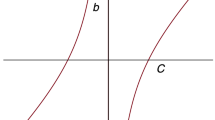Abstract
To deal specifically with the case of a nearly antipodal geodesic of given terminal positions, an equation in azimuth is produced for solution by the Newton-Raphson Method of successive approximation. When the azimuth is in the region of 90° it is found that an approach is best made by a development in series when the aim is precision calculation. Degeneracy is examined theoretically and graphically.
Similar content being viewed by others
Abbreviations
- e:
-
eccentricity of the spheroid
- f:
-
flattening of the spheroid
- φ1, φ2 :
-
geographical latitudes of the ends of the lineP 1 ,P 2 respectively
- U 1 ,U 2 :
-
parametric latitudes corresponding to φ1, φ2 respectively
- L :
-
difference in geographical longitude between the ends of the lineP 1 P 2 . Also as longitude for a point at parametric latitude U on a geodesic for terms ofdU/dL, etc...
- a 1,a 2 :
-
azimuths at the ends of the lineP 1 ,P 2 respectively
- a :
-
azimuth of the line at the equator
- λ:
-
spherical difference in longitude corresponding toL
- σ:
-
spherical central angle
- θ:
-
90°−a
- s1 :
-
sinU1
- c1 :
-
cosU1
- s2 :
-
sinU2
- c2 :
-
cosU2
Reference
H. F. RAINSFORD: Long geodesics on the ellipsoid., B. Géodésique, 37, 12–22. 1955.
Author information
Authors and Affiliations
Rights and permissions
About this article
Cite this article
Bowring, B.R. Solution for azimuth of the geodesic in near antipodal situations with special reference to the behaviour of lines for which the azimuth is in the region of 90°. Bull. Geodesique 51, 17–32 (1977). https://doi.org/10.1007/BF02521538
Received:
Revised:
Published:
Issue Date:
DOI: https://doi.org/10.1007/BF02521538




